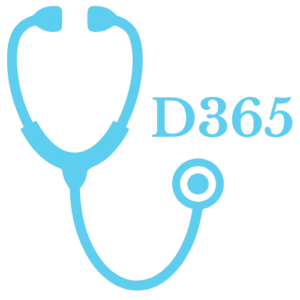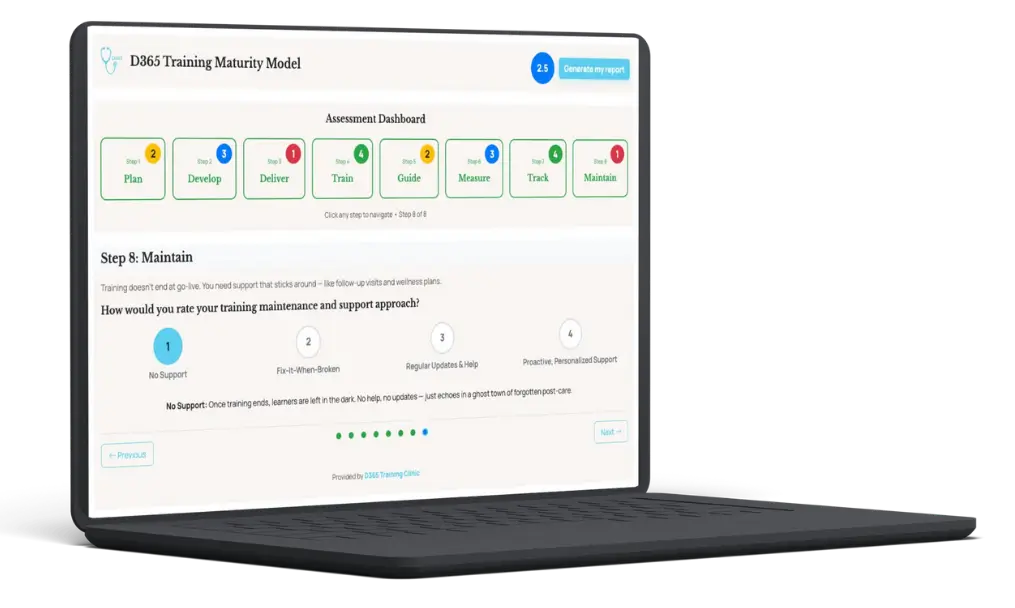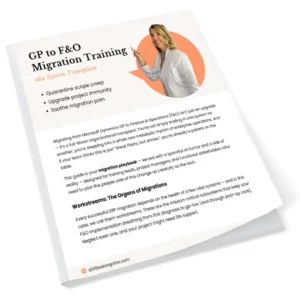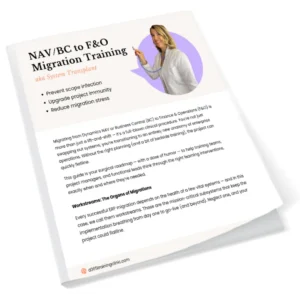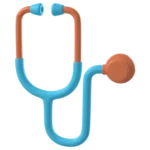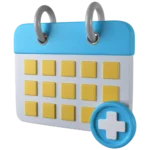D365 Training Maturity Model
aka Wellness Chart
Is your D365 training stuck in the ER — rushed, reactive, and barely breathing? This model walks it to rehab, builds muscle, and sets it up for a full recovery.
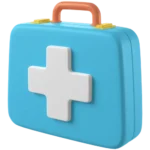
Table of Content
Ready to test your health?
Take our quick D365 Training Maturity Checkup — it’s completely free and only takes a minute to see where you stand. You’ll get personalized insights and tips to boost your training results.

Get Free eBook
Join the clinic rounds — we’ll send you expert-approved remedies straight to your inbox.
D365 Training Maturity Model
aka Wellness Chart
Welcome to the D365 Training Maturity Model — your prescription for a healthier, smarter training program. Think of this as your organization’s annual wellness exam for learning and development. If you’ve been throwing training plans together like aspirin on a headache, it’s time for a more clinical approach.
This model helps you assess and evolve your D365 training strategy across eight essential steps — from planning your first move to maintaining your momentum. Each step represents a different vital sign of your training program, and each is tracked through four levels of maturity:
- Unstructured (Level 1) – Symptoms present, but no clear diagnosis.
- Reactive (Level 2) – Spot treatments after symptoms flare up.
- Managed (Level 3) – Scheduled checkups and follow-through.
- Innovative (Level 4) – Preventive care and peak performance.
With a bit of humor and a lot of insight, this model shows how to go from training in chaos to continuous, scalable growth. Let’s start your organizational checkup!
🩺 Step 1: Plan
This is where you decide whether your training strategy is a scribbled prescription or a full patient care plan. The maturity levels here reflect how intentional and sustainable your training design is.
Level | Diagnosis | Description |
|---|---|---|
Level 1 – Unstructured | No Plan | You’re winging it. Training happens when someone screams loud enough. No documentation, no calendar, no goals. All crisis, no strategy. |
Level 2 – Reactive | One-Time Training | You’ve scheduled a training — hooray! But it’s a one-and-done session. Train-the-trainer falls into this category. Once users attend, they’re expected to retain everything. Like a flu shot expected to last forever. |
Level 3 – Managed | Periodic Training | Training happens on a cadence — maybe quarterly or aligned with releases. There’s planning, budgeting, and iteration. Checkups are scheduled, even if they slip. |
Level 4 – Innovative | Continuous Training | Training is a living system. New employees get structured onboarding; veterans get upskilling. Training is treated like wellness — always proactive and evolving. |
How to Improve: To elevate your training planning maturity, invest in a structured training program that aligns with business objectives and user needs. Establishing a repeatable training lifecycle, with clear ownership and scheduled cadences, brings order to the chaos. Use onboarding templates, change management support, and role-based program structures to shift from reactive scheduling to a proactive education strategy.
🔬 Step 2: Develop
This stage measures whether your learning materials are actually suited to your organization — or just generic templates slapped onto specific needs.
Level | Diagnosis | Description |
|---|---|---|
Level 1 – Unstructured | No Content | There’s no official training content. Maybe a dusty user manual and some internal tribal knowledge. Users are Googling and praying — like self-prescribing herbs for a broken leg. |
Level 2 – Reactive | Standard Content | You’re using Microsoft Learn or another off-the-shelf solution. It’s helpful but not tailored. Users must bridge gaps between training and real business processes. |
Level 3 – Managed | Standard + Custom (Separate) | You’ve developed internal content — SOPs, walkthroughs, videos — but they’re siloed from standard materials. Like two pharmacies that don’t share patient records. |
Level 4 – Innovative | Unified, Custom-Enabled Platform | All training lives in one place. It’s branded, embedded in workflows, and tailored. Delivery feels like precision medicine — effective, seamless, and user-friendly. |
How to Improve: Creating and maintaining a library of custom courses tailored to your specific processes and terminology is key to moving up the maturity model. Use tools that enable you to create short, modular courses that reflect your own business scenarios. Mapping these to standard concepts helps bridge the gap between out-of-the-box content and your real-world needs, making training both relevant and engaging.
🧬 Step 3: Deliver
This stage looks at how you actually deliver the medicine — or in this case, the training. Is it a home visit or do users have to line up at an inconvenient clinic?
Level | Diagnosis | Description |
|---|---|---|
Level 1 – Unstructured | Manual and Ad Hoc | Everything is emailed, spreadsheeted, or spread by word of mouth. No learning platform, just DIY chaos — the healthcare equivalent of back-alley diagnostics. |
Level 2 – Reactive | Scheduled (Fixed Time/Location) | Training is on the calendar, often via Zoom or in-person. It’s rigid — if you miss it, you miss it. Like scheduling a checkup with no reschedule policy. |
Level 3 – Managed | On-Demand | Training is available when needed: videos, modules, searchable content. It’s like telemedicine — convenient, fast, and accessible. |
Level 4 – Innovative | Self-Paced, Anytime, Anywhere | The platform is smart, mobile, and personalized. Learning happens in the flow of work — like carrying your own pocket doctor, minus the co-pay. |
How to Improve: Implementing a centralized, online training platform gives users consistent, always-available access to resources. Self-paced training that integrates with your systems helps eliminate bottlenecks and supports a wide range of learners. Features like content tagging, searchability, and embedded support make training frictionless and scalable across teams.
🧠 Step 4: Train
This stage focuses on the dosage. Are you giving your learners digestible treatments or dumping the whole pharmacy on them at once?
Level | Diagnosis | Description |
|---|---|---|
Level 1 – Unstructured | Long, Generic, No Practice | Trainings are long lectures with minimal relevance. Everyone gets the same pill — even if their symptoms are different. It’s inefficient and exhausting. |
Level 2 – Reactive | Short, Generic, No Practice | Sessions are shorter, but still generic. Like handing out aspirin without checking for migraines or muscle pain. Better than nothing, but far from ideal. |
Level 3 – Managed | Short, Skill-Based, No Practice | Lessons are now digestible and role-focused. Each has a goal, but lacks interactivity — learners know what to do, but not how to do it confidently. |
Level 4 – Innovative | Short, Skill-Based, Hands-On | Bite-sized and action-oriented, with real exercises and feedback. Like a clinical rotation — learners build confidence through experience, not just theory. |
How to Improve: Break complex concepts into micro-courses that target specific tasks or features. Use a framework that lets you quickly create and deploy short, scenario-based lessons that can be reused and updated over time. Embedding learning into the user’s workflow allows training to happen in the moment of need — reinforcing habits and increasing retention.
🧭 Step 5: Guide
This step is about giving your learners a map — not just dropping them in the forest with a compass. A well-structured path means users always know what’s next.
Level | Diagnosis | Description |
|---|---|---|
Level 1 – Unstructured | No Path | Learners wander aimlessly with scattered docs and no guidance. Like being lost in a hospital with no signage — lots of hallways, no direction. |
Level 2 – Reactive | One-Size-Fits-All | Everyone takes the same training, regardless of their role. Like prescribing the same pill for headaches and heartburn — results are hit or miss. |
Level 3 – Managed | Modular & Role-Based | Training is structured into modules that match user roles. Finance learns finance. Ops learns ops. You’ve finally got a map with “You Are Here.” |
Level 4 – Innovative | Adaptive & Personalized | Learning adapts based on behavior, progress, and role. You’ve got a smart GPS guiding your training journey — always recalculating and adjusting. |
How to Improve: Develop structured learning paths for different roles and experience levels. These paths should string together relevant micro-courses into curated journeys that build competence step-by-step. Supporting users with suggested next steps and personalized routes increases motivation and makes growth feel attainable.
🧪 Step 6: Measure
Let’s be honest: if you’re not checking vitals, how do you know your patient is healing? This step ensures you have ways to evaluate progress — not just hope for the best.
Level | Diagnosis | Description |
|---|---|---|
Level 1 – Unstructured | No Tests | Training ends and… that’s it. No quizzes, no reviews. No idea if anyone learned anything. It’s like treating in the dark without even checking vitals. |
Level 2 – Reactive | Basic Quizzes | There are quizzes, but they’re generic and offer minimal feedback. Like checking your pulse and calling it a full physical exam. |
Level 3 – Managed | Role-Relevant Assessments | Assessments are tailored to roles and provide feedback. Learners know what they missed and how to improve — like getting a report with doctor’s notes. |
Level 4 – Innovative | Gamified, Diagnostic Assessments | Fun, adaptive, and actionable. Learners get next steps and managers see readiness. It’s like wearing a Fitbit for your brain — and it even sends alerts. |
How to Improve: Incorporate assessments that provide actionable feedback. Even simple quizzes can uncover knowledge gaps, but diagnostic-style evaluations tied to training paths add much more value. Use results to guide learners to remediation or the next level, and let managers use insights to support growth — not just track scores.
📊 Step 7: Track
Training without tracking is like a checkup with no chart. This step ensures you can monitor who’s learning what — and where to intervene.
Level | Diagnosis | Description |
|---|---|---|
Level 1 – Unstructured | No Visibility | You have no idea who’s been trained. It’s like prescribing meds but forgetting who took what — fingers crossed and no chart in sight. |
Level 2 – Reactive | Individual Logs | Some logs exist, usually in spreadsheets, but no big-picture insight. You’re flipping through patient records one page at a time. |
Level 3 – Managed | Team Dashboards | Managers can see who’s completed what, and the data starts to make sense. The clinic now has computers — and they work. |
Level 4 – Innovative | Organization-Wide Insights | Performance trends, red flags, and adoption gaps are visible at a glance. You’ve moved from triage to population-level care. |
How to Improve: Enable organization-wide tracking through a dashboard that shows training status, completion rates, and progress by team or department. Visibility helps identify adoption trends and problem areas early. Use filters, drill-downs, and reporting tools to support data-driven decisions about where and how to intervene.
🩹 Step 8: Maintain
Training doesn’t end at go-live. You need support that sticks around — like follow-up visits and wellness plans.
Level | Diagnosis | Description |
|---|---|---|
Level 1 – Unstructured | No Support | Once training ends, learners are left in the dark. No help, no updates — just echoes in a ghost town of forgotten post-care. |
Level 2 – Reactive | Fix-It-When-Broken | Support only kicks in when complaints roll in. You’re stuck in a constant cycle of emergency triage and damage control. |
Level 3 – Managed | Regular Updates & Help | Support is expected and consistent. Learners know where to turn, and updates arrive like flu shots — timely and preventive. |
Level 4 – Innovative | Proactive, Personalized Support | Contextual help, embedded guidance, and real-time nudges. Support evolves with the platform — like a wellness coach who lives in your app. |
How to Improve: Build a structured support plan that includes contextual help, regular training refreshers, and updates aligned with product changes. Use self-service tools like searchable help libraries and built-in guidance to keep users self-sufficient. Proactive communication and evergreen content keep knowledge fresh and frustration low.
🩺 Ready to run your own diagnostics?
Use the chart below to self-assess, prescribe the right interventions, and begin building a training program that actually heals.
Maturity Stage | Level 1 | Level 2 | Level 3 | Level 4 |
Unstructured | Reactive | Managed | Innovative | |
Plan | No Plan | One Time Training | Periodic Training | Continuous Training |
Develop | No Content | Standard Content | Standard + Custom (Separate) | Unified Custom-Enabled Platform |
Deliver | Manual and Add hoc | Scheduled (Fixed time and Location) | On-Demand | Self-Paced, Any time, Any where |
Train | Long, Generic, No Practice | Short, Generic, No Practice | Short, Skill-based, No practice | Short, Skill-based, Hands-on |
Guide | No Path | One-Size-Fits-All | Moduler & Role-Based | Adaptive & Personalized |
Measure | No Assessments | Basic Quizzes | Role-Relevant Assessments | Gamified, Diagnostic Assessments |
Track | No Visibility | Individual Logs | Team Dashboards | Organization-Wide Insights |
Maintain | No Support | Fix-It-When-Broken | Regular Updates & Help | Proactive, Personalized Support |
That’s your full training health check — eight steps, four levels, one clear path to learning wellness. Whether you’re just getting started or ready for advanced care, the D365 Training Maturity Model gives you the tools to chart your course.
